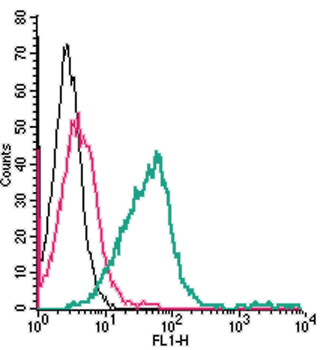Overview
- Peptide (C)NGTDPYKPK(S)PESD, corresponding to amino acid residues 999-1012 of human TRPM2 (Accession O94759). Extracellular, 3rd loop.

 Cell surface detection of TRPM2 by direct flow cytometry in live intact mouse BV-2 microglia cells:___ Cells.
Cell surface detection of TRPM2 by direct flow cytometry in live intact mouse BV-2 microglia cells:___ Cells.
___ Cells + Rabbit IgG isotype control-FITC.
___ Cells + Anti-TRPM2 (extracellular)-FITC Antibody (#ACC-128-F), (2.5µg) . Cell surface detection of TRPM2 by direct flow cytometry in live intact human THP-1 monocytic leukemia cells:___ Cells.
Cell surface detection of TRPM2 by direct flow cytometry in live intact human THP-1 monocytic leukemia cells:___ Cells.
___ Cells + Rabbit IgG isotype control-FITC.
___ Cells + Anti-TRPM2 (extracellular)-FITC Antibody (#ACC-128-F), (2.5µg) .
- Fleig, A. et al. (2004) Trends. Pharmacol. Sci. 25, 633.
- Kraft, R. et al. (2005) Pflugers. Arch. 451, 204.
- Huang, C.L. (2004) J. Am. Soc.Nephrol. 15, 1690.
- Montell, C. (2005) Sci. STKE. 2005, re3.
- Du, J. et al. (2009) Proc. Natl. Acad. Sci. U.S.A. 106, 7239.
The mammalian melastatin-related transient receptor potential (TRPM) is a subfamily of the TRP family. The family was named after the first discovered member, melastatin (TRPM1) whose gene was identified in metastatic and benign melanomas1-3.
The TRPM family consists of eight members: TRPM1-8 that can be further divided into four pairs: TRPM1 and TRPM3; TRPM2 and TRPM8; TRPM4 and TRPM5; and TRPM6 and TRPM71,2.
The TRPM proteins share structural homology with other members of the TRP superfamily channels; six putative transmembrane domains, and cytoplasmic N- and C-termini. However, due to their long N- and C-termini they are also named the long TRP channel family1-3.
The C-terminal regions of three TRPM members (TRPM2, TRPM6 and TRPM7) are occupied by enzymatic domains. Almost all the C-terminal region of TRPM2 has an enzymatic domain with sequence similarities to Nudix hydrolases (cleave mononucleotide and dinucleotide polyphosphates2,4.
TRPM2 (LTRpC2, TrpC7) is a Ca2+-permeable, nonselective cation channel that is predominantly expressed in various regions of the brain, where it is preferentially localized in microglial cells, the host macrophages of the central nervous system and is also expressed in other tissues, including spleen, heart, liver, lung, and bone marrow. Several splice variants of TRPM2 have been identified5,3.
Application key:
Species reactivity key:
Anti-TRPM2 (extracellular) Antibody (#ACC-128) is a highly specific antibody directed against an extracellular epitope of the human protein. The antibody can be used in western blot, immunohistochemistry and live cell flow cytometry applications. It has been designed to recognize TRPM2 from human, mouse and rat samples.
Anti-TRPM2 (extracellular)-FITC Antibody (#ACC-128-F) is directly conjugated to fluorescein isothiocyanate (FITC) fluorophore. This conjugated antibody has been developed to be used in immunofluorescent applications such as direct flow cytometry and live cell imaging.
